From the Black Hills Pioneer, Aug. 21, 2021: The former Homestake Gold Mine in Lead, SD was dedicated as the M. Michael Rounds Operations Center at the Sanford Underground Research Facility. The dedication event included remarks from many dignitaries including Sanford Lab Executive Director Mike Headley, who talked about the long journey it has been to support the new facility and that Sanford Lab has made great strides toward building the LBNF that will house the Deep Underground Neutrino Experiment at 4,850 level, led by Fermilab.








